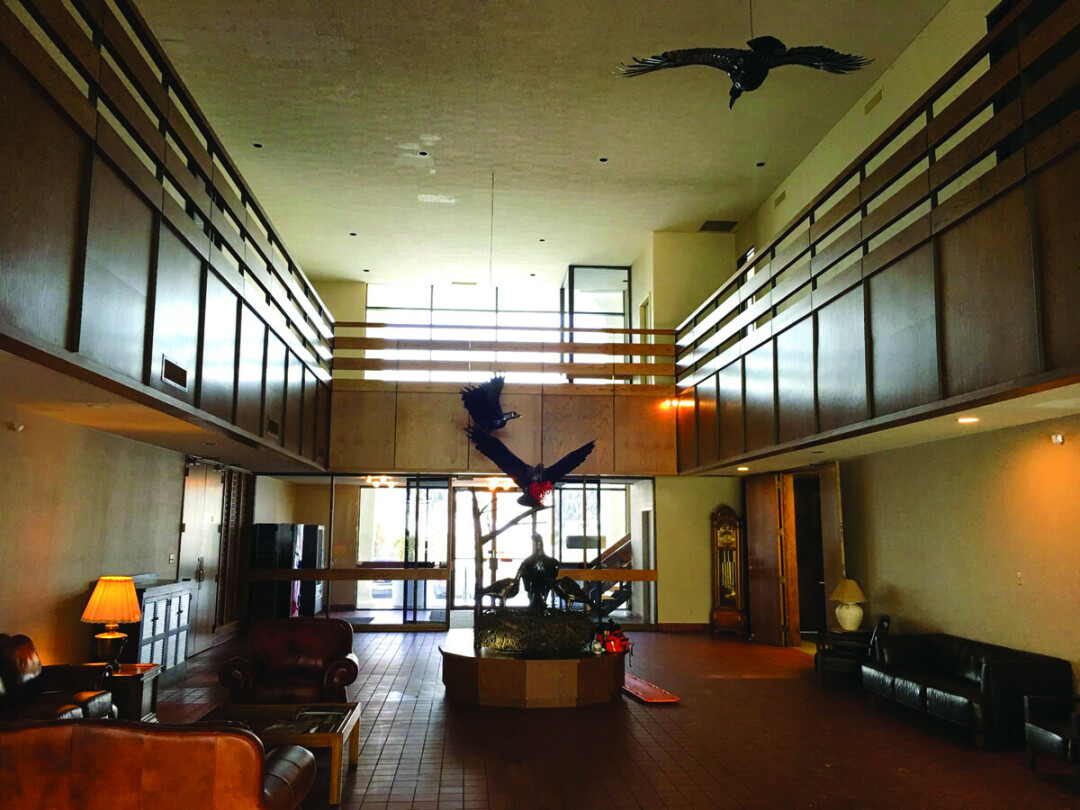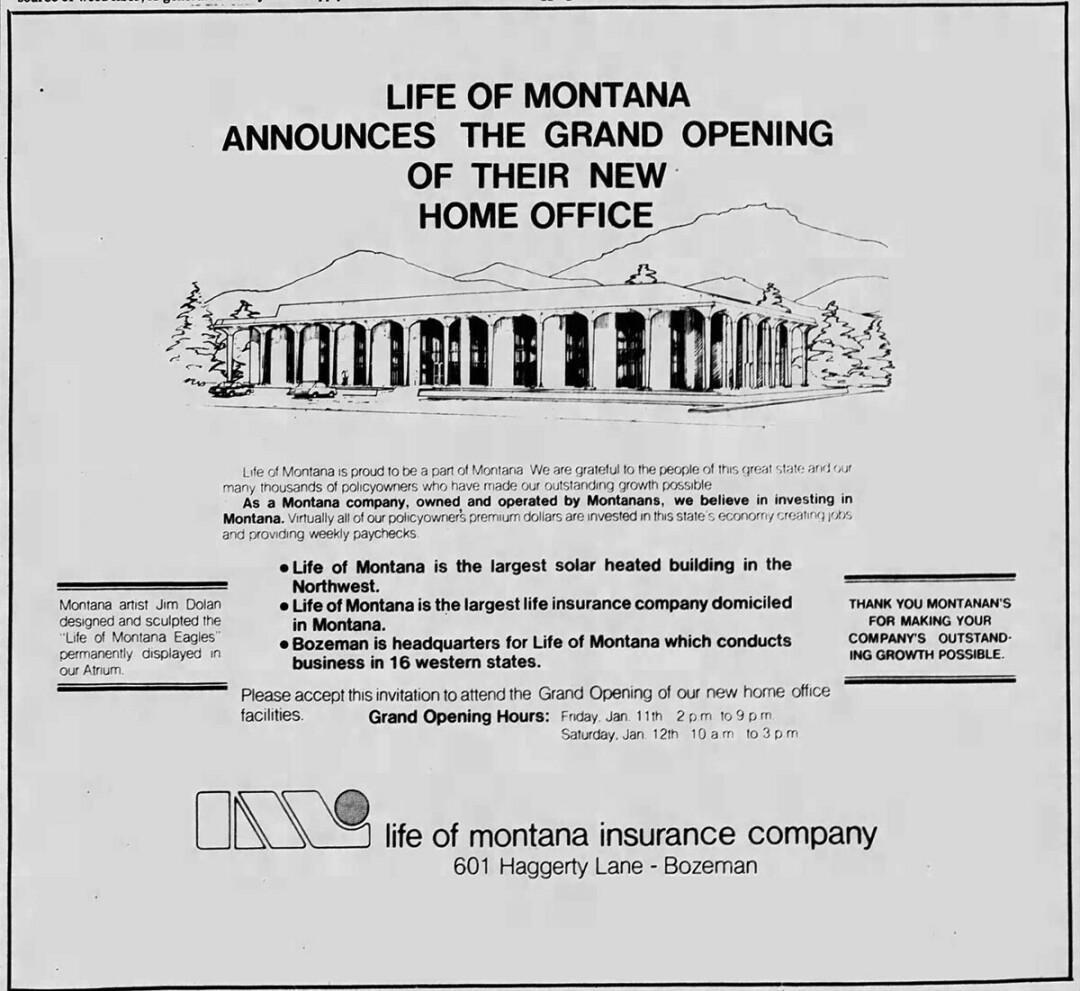The Life of Montana Legacy
Lesley Gilmore | Friday Jul. 1st, 2022

“Life of Montana” conjures something larger than life and bigger than Montana. Although the Life of Montana Insurance Company was not too big to fail, its signature building at the outskirts of Bozeman remains as testimony to the aspirations it fulfilled. The legacy remains.
We have all seen it; some of us love it, some of us don’t, but what is it? Life of Montana, up on the hill overlooking—and seen from—I-90 is a temple of commerce. As Bozeman’s finest example of Modern-era architecture, it was built near the end of the era, in1978. Oddly, this representation of a Montana-sized dream originated in the plains of Texas. This is the story of the Life of Montana building at 601 Haggerty Lane, the modernist building that represents the growth of a life insurance company that absorbed other companies on its way to its place at the top of the hill.
Most tales of such explosive progress include a driver who instigates and implements grand ideas. The changemaker of the Life of Montana Insurance Company was Herbert E. Richards. Herb had been born in Detroit, Michigan in 1925 and, by age 21, was living in Waco, Texas. He and his wife Lola had four children in short order, all born in Waco. Herbert’s job as a Sears’ salesman likely made it hard to make ends meet, prompting his move in 1958 to the Consolidated American Life Company in Waco. Consolidated American Life became a training course for Herb, as well as a model for his future ventures in Montana. Former congressman and future senator from Texas, Lloyd M. Bentsen Jr.’s family founded Consolidated in 1955 and shepherded its quick rise to the list of top ten insurance companies in Texas. When Herbert’s started there, it had more than $36 million of insurance in force. Herb did not stay with the Bentsen family long; by 1966 he was in Idaho. By 1970 he was in Bozeman, changing the name and future of the Gallatin National Life Insurance Company.
In 1971, Herb Richards reinvented Gallatin National Life as the Life of Montana Insurance Company (LOMIC) with a larger, national mission. He took advantage of new legislation that allowed Montana firms to bring into the state the resources of out-of-state companies. At the time of renaming, LOMIC consolidated with the Insurance Investment Corporation of Oklahoma City and Equity National Life Insurance Company of Phoenix. In July 1975, LOMIC purchased 89% of the Transwestern Life Insurance Company of Billings. In 1977, LOMIC bought Glacier Life of Kalispell. These purchases contributed to increased assets, from $980,000 in 1970 to $4.5 million in 1976, to $40 million in 1983. During this time, LOMIC expanded to serve sixteen western states, opening offices in Great Falls, Rapid City, and Helena.
Expansion of business resulted in a larger work force, necessitating a move to a bigger office, from 27 North Tracy to 28 North Black in 1974. This latter location became a thorn in a later land swap with the city. In 1976, LOMIC wanted a larger site for a larger building—and the city had just the place, on the east side of Bozeman. The city proposed an exchange of two different land parcels: the city site to provide sufficient space for LOMIC’s new building and parking, and the other to increase the city’s cemetery. The city seems to have held this deal hostage pending LOMIC’s sale of the 28 North Black site to Bozeman’s Parking Commission, for use as a surface parking lot. LOMIC’s attorney called the delay of the sale “a pretty lousy deal,” declaring the two matters were unrelated. They completed the swap a week after the city lifted the suspension; the city agreed to rezone and trade 12.5 acres of land just east of the City Softball Complex to become LOMIC’s 601 Haggerty Lane property. In exchange, LOMIC gave the city 12.3 acres of land adjacent to Sunset Hills Cemetery. Richards stated publicly that without these trades, LOMIC would have had to move to their old Transwestern building in Billings. Perhaps this is why Bozeman later sweetened the deal with the issuance of a low-interest, tax-free 20-year revenue bond to help finance the $2.75 million construction of the new LOMIC building, saving the company $100,000. 
What did Bozeman gain from the transaction? A striking, modern building on a site that could celebrate it. And where did Richards get the idea for this building? From Waco, Texas, of all places. Back in June 1974, the Waco Savings & Loan had broken ground on a new building designed by the notable Waco firm of Bennett, Carnahan, Hearn & Thomas. Bennett et al. were well established and comfortable with the Modern styles, accustomed to designing commercial, hospital, and educational buildings; working with precast concrete featuring exposed aggregate, and employing tinted glass as a primary wall system. The architecture firm’s principals were directors of the Waco Chamber of Commerce, serving alongside Ralph Adams, the vice president of the Waco Savings & Loan. It is likely Herb Richards knew them and their work while living in Waco and that he saw the Savings & Loan building on a return trip to Waco. He later met with Bennett’s team and hired them to replicate their design for Life of Montana in Bozeman. Richards also hired local architect Richard (Dick) Shanahan, one of a handful of architects then in Bozeman (how times have changed) to be the architect-of-record. Dick welcomed a year of certain income, during which he managed the construction of the project.
Dick Shanahan is the closest we can now come to the beginnings of the Life of Montana temple. He handily tells of Wayne Edsel leading his eponymous firm in the construction, which includes a one-foot-thick slab over big footing pads, as designed for the poor Texas soil—and more than this site needed. Wayne had a plasterer from North Dakota manage a six to-eight-person crew to stucco the exterior columns. The whole crew had to navigate the below-zero temperatures that winter. And the glazing of the regular series of tall window expanses was Valley Glass’s first big job.
The Modern style that graces this building is called Formalism for its strong ties to the Classical styles. The regular array of columns defining eleven and five bays at the long and short facades of the building have capitals that flare out and up, as if to the Gods of Commerce. The standard hallmarks of Formalism were obeyed: strict symmetry, a flat, projecting roofline, and high-quality materials. A slight rebellion against the final trait of smooth wall surfaces was waged with vertically ribbed concrete walls flanking the glazing.
As known today, Montana might be cold, but that’s balanced with ample sunshine, an attribute that did not escape the LOMIC team. Richards used his seemingly breezy ability to get money when receiving a $208,000 federal Department of Energy (DOE) grant to provide experimental solar heating for the building. Montana’s Department of Natural Resources supplemented this with $59,500, and LOMIC threw in $64,000. Boasted to be “one of the best demonstration projects,” DOE planned to invest $250,000 to monitor the system (I have found no such reports). During the groundbreaking ceremonies —attended by Governor Tom Judge and State Auditor Sonny Omholt— the building with an 18,900-square-foot footprint was purported to be the largest commercial building in Bozeman and, with the arrays of solar collectors, “the largest solar-assisted commercial structure in the Northwest.” Although on the January 14, 1980 dedication day, the solar heating failed due to lack of sun, the system ultimately performed better than anticipated, reducing expected monthly heating bills of $3,200 to $688. It is unknown if this cost was just for LOMIC on the first floor, or if it included the second-floor tenants. The seven rows of collectors remain; it is unknown if they work.
The January 1980 grand opening announcement exuded hope of life eternal—of the largest and the best—including a new logo designed by an MSU design class. Yet the deep recession of the early 1980s hit our big giant hard. Herb Richards was able to breathe a few more years of life into the firm by welcoming, and likely courting, a takeover by the American Plan Corporation of New York and Texas. The beautiful building and solid work force accustomed to lower wages than New Yorkers were strong selling points. With American Plan’s infusion of additional assets, he hoped to be able to increase the number of employees from 45 to 90 from 1983 to 1985. This did not happen. American Plan began to sell off the company’s assets in early 1984 to “cover the $1.6 million backlog of insurance policy payments.” In 1987, the state and the courts judged that American Plan could no longer meet its financial obligations. In January 1988, the court deemed the firm insolvent by nearly $24 million and ordered it liquidated. The firm was dissolved on December 3, 1990.
The spirit of the Life of Montana lives on in its namesake building, still considered a prestigious office building on an attractive site. It is privately owned and operated, but if you ask nicely, you might get to experience the warmth of the large central lobby that bisects the building. Jim Dolan’s eagle sculptures are suspended in the two-story space that joins natural light and views from both the north and the south. This atrium, identical to that of the Waco Savings & Loan, is indicative of the gentle grace of Modern interiors from Texas to Montana.
| Tweet |
